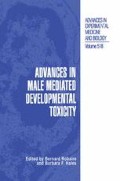Abstract
It is clear from many of the chapters in this volume that exposure of males to toxic chemicals or radiation can adversely affect subsequent generations. The endpoints for these adverse effects on progeny outcome have varied from pre-implantation and/or postimplantation death, to malformations, altered behaviour, or cancer. Effects may not be manifested until adulthood. Furthermore, several studies have shown that even “apparently normal” F1 offspring can transmit adverse effects to the F2 generation (Auroux et al., 1988; Hales et al, 1992)
Access this chapter
Tax calculation will be finalised at checkout
Purchases are for personal use only
Preview
Unable to display preview. Download preview PDF.
REFERENCES
Auroux, M., Dulioust, E.J.B., Nawar, N.N.Y., Yacoub, S.G., Mayaux, M.J., Schwartz, D., and David, G., 1988, Antimitotic drugs in male rat. Behavioral abnormalities in the second generation. J Androl. 9:153–159.
Bishop, J.B., and Kodell, R.L., 1980, The heritable translocation assay: its relationship to assessment of genetic risk for future generations. Teratog Carcinog Mutagen. 1:305–332.
Clegg, E.D., Perreault, S.D., and Klinefelter, G.R., 2001, Assessment of Male Reproductive Toxicity, in: Principles and Methods of Toxicology, Fourth Edition, A. Wallace Hayes, ed., Taylor & Francis, Philadelphia, p. 1263.
Ehling, U.H., Machemer, L., Buselmaier, W., Dycka, J., Frohberg, H., Kratochvilova, J., Lang, R., Lorke, D., Muller, D., Peh, J., Rothrborn, G., Roll, R., Schulze-Schencking, M., and Wiemann, H., 1978, Standard protocol for the dominant lethal test on male mice set up by the work group “Dominant Lethal Mutations of the ad hoc Committee Chemogenetics”. Arch. Toxicol. 39:173–186.
Generoso, W.M., 1980, Repair in fertilized eggs of mice and its role in the production of chromosomal aberrations. Basic Life Sci. 15:411–420.
Green, S., Auletta, A., Fabricant, R., Kapp, M., Sheu, C, Springer, J., and Whitfield, B., 1985, Current status of bioassays in genetic toxicology: The dominant lethal test. Mutation Res. 154:49–67.
Hales, B.F., Crosman, K., and Robaire, B., 1992, Increased postimplantation loss and malformations among the F2 progeny of male rats chronically treated with cyclophosphamide. Teratology. 45:671–678.
Kelly, S.M., Robaire, B., and Hales, B.F., 1992, Paternal cyclophosphamide treatment causes postimplantation loss via inner cell mass-specific cell death. Teratology. 45:313–318.
Klemm, M., Genschow, E., Pohl, I., Barrabas, C, Liebsch, M., Spielmann, H., 2001, Permanent embryonic germ cell lines of BALB/cJ mice-an in vitro alternative for in vivo germ cell mutagenicity tests. Toxicolln Vitro. 15:447–453.
Knudsen, I., Hansen, E.V., Meyer, O.A., and Poulsen, E., 1977, A proposed method for the simultaneous detection of germ-cell mutation leading to fetal death (dominant lethality) and of malformation (male teratogenicity) in mammals. Mutat Res. 48:267–270.
Robaire, B., Smith, S. Hales, B., 1984, Suppression of spermatogenesis by testosterone in adult male rats: Effect on fertility, progeny outcome and pregnancy. Biol Reprod. 31:221–230.
Rohrborn, G., 1970, The dominant lethals: Method and cytogenetic examination of early cleavage stages, in: Chemical Mutagenesis in Mammals and Man, F. Vogel and G. Rohrborn, eds., Springer-Verlag, Heidelberg, p. 148.
Russell, L.B., Selby, P.B., von Halle, E., Sheridan, W., and Valcovic, L., 1981, The mouse specific-locus test with agents other than radiations: interpretation of data and recommendations for future work. Mutat Res. 86:329–354.
Trasler, J.M., Hales, B.F., and Robaire, B., 1985, Paternal cyclophosphamide treatment of rats causes fetal loss and malformations without affecting male fertility. Nature. 316:144–146.
Trasler, J.M., Hermo, L., Robaire, B., 1988, Morphological changes in the testis and epididymis of rats treated with cyclophosphamide: a quantitative approach. Biol Reprod. 38:463–479.
Tyl, R.W., Friedman, M.A., Losco, P.E., Fisher, L.C., Johnson, K.A., Storther, D.E. and Wolf, C.H., 2000, Rat two-generation reproduction and dominant lethal study of acrylamide in drinking water. Reprod Toxicol. 14:385–401.
U. S. Environmental Protection Agency, 1998, Health Effect Test Guidelines OPPTS 870.3800 Reproduction and Fertility Effects, U.S. Government Printing Office, Washington, D.C.
U. S. Environmental Protection Agency, 1998, Health Effect Test Guidelines OPPTS 870.5450 Rodent Dominant Lethal Assay, U.S. Government Printing Office, Washington, D.C.
Working, P.K., and Chellman, G.J., 1989, The use of multiple endpoints to define the mechanisms of action of reproductive toxicants and germ cell mutagens. Prog Clin Biol Res. 302:211–227.
World Health Organization: WHO Laboratory Manual for the Examination of Human Semen and SpermCervical Mucus Interaction, 34th ed. Cambridge, UK, Cambridge University Press, 1999.
Author information
Authors and Affiliations
Editor information
Editors and Affiliations
Rights and permissions
Copyright information
© 2003 Springer Science+Business Media New York
About this chapter
Cite this chapter
Hales, B.F., Cyr, D.G. (2003). Study Designs for the Assessment of Male-Mediated Developmental Toxicity. In: Robaire, B., Hales, B.F. (eds) Advances in Male Mediated Developmental Toxicity. Advances in Experimental Medicine and Biology, vol 518. Springer, Boston, MA. https://doi.org/10.1007/978-1-4419-9190-4_25
Download citation
DOI: https://doi.org/10.1007/978-1-4419-9190-4_25
Publisher Name: Springer, Boston, MA
Print ISBN: 978-1-4613-4829-0
Online ISBN: 978-1-4419-9190-4
eBook Packages: Springer Book Archive

